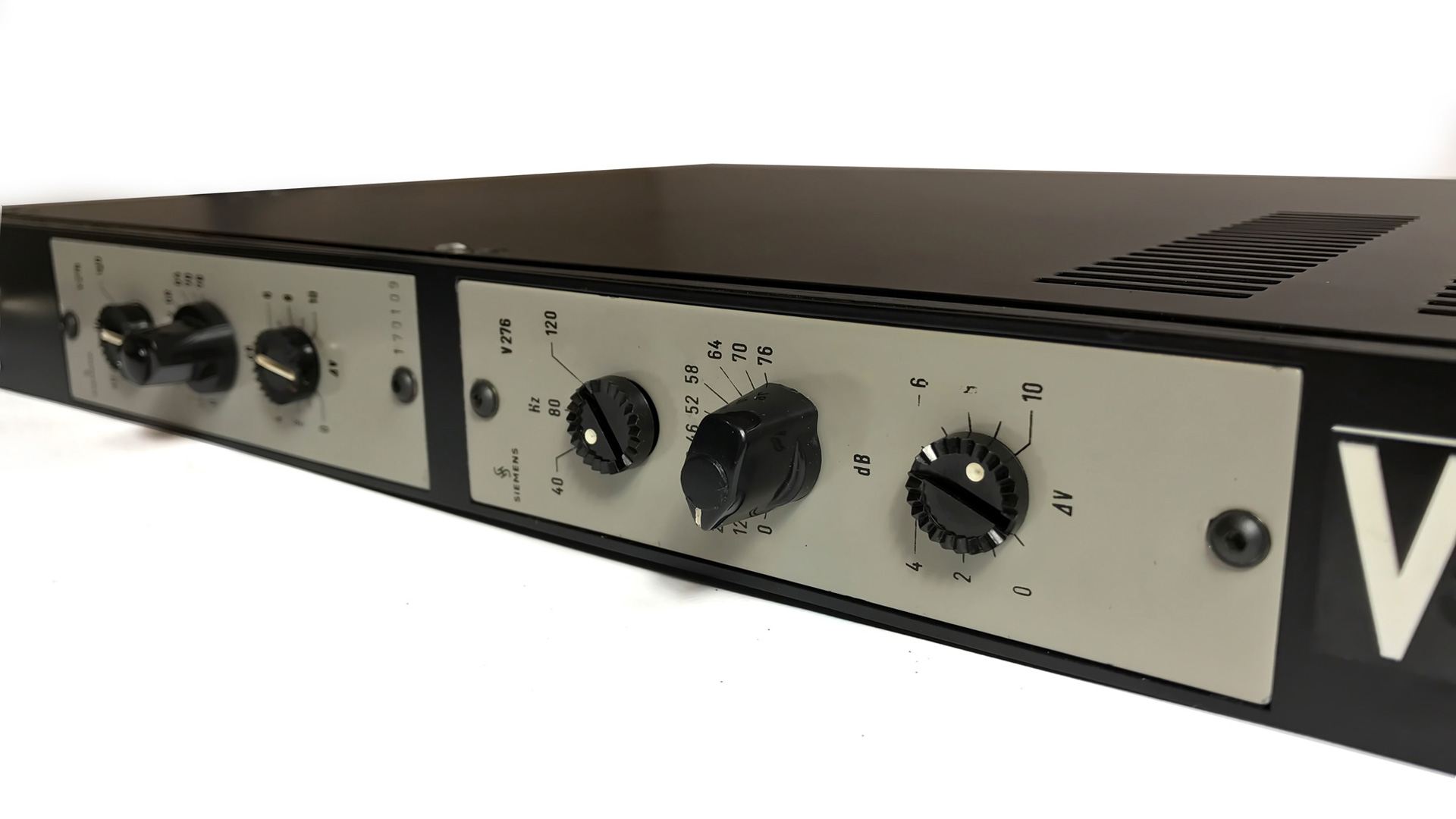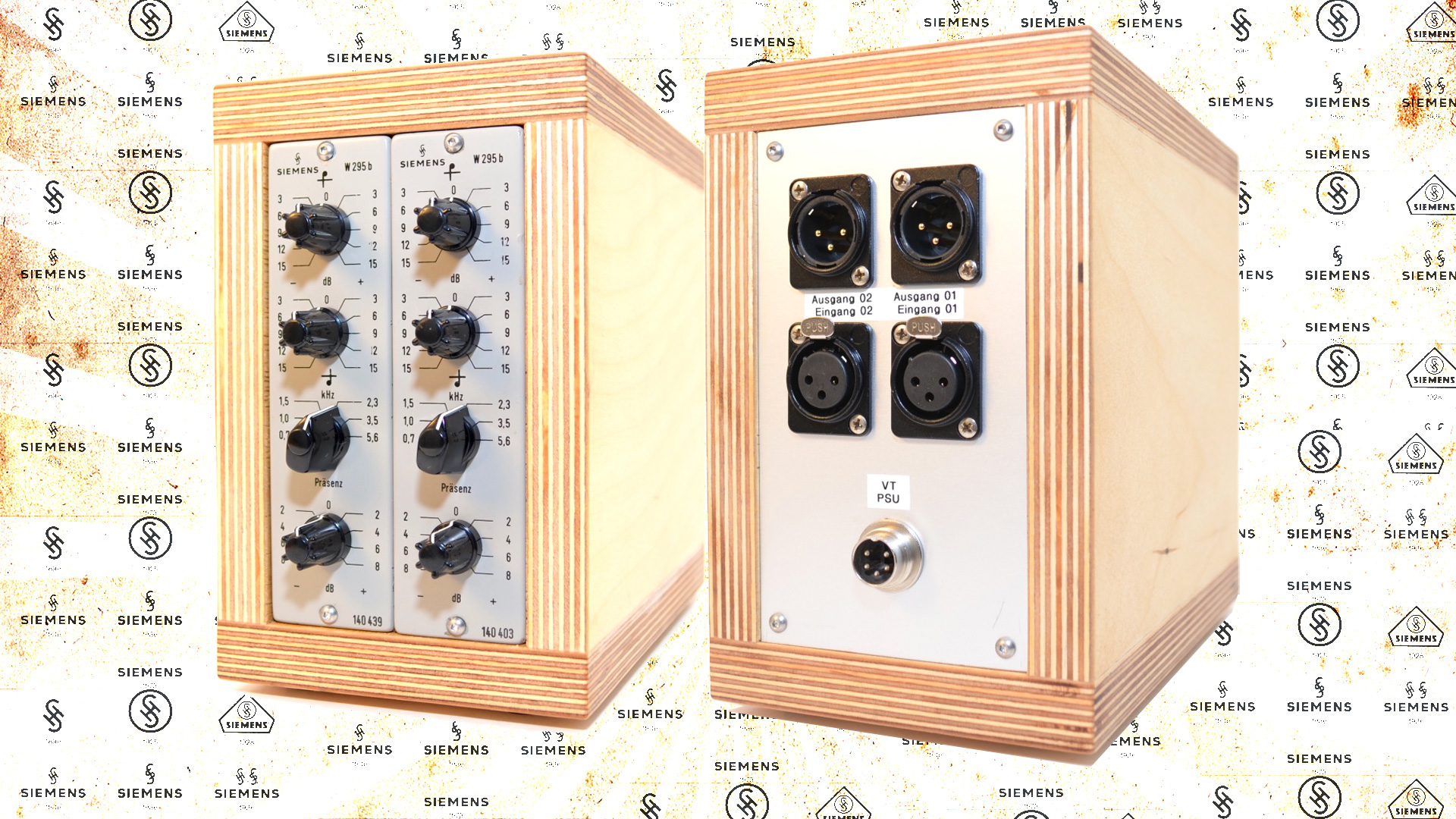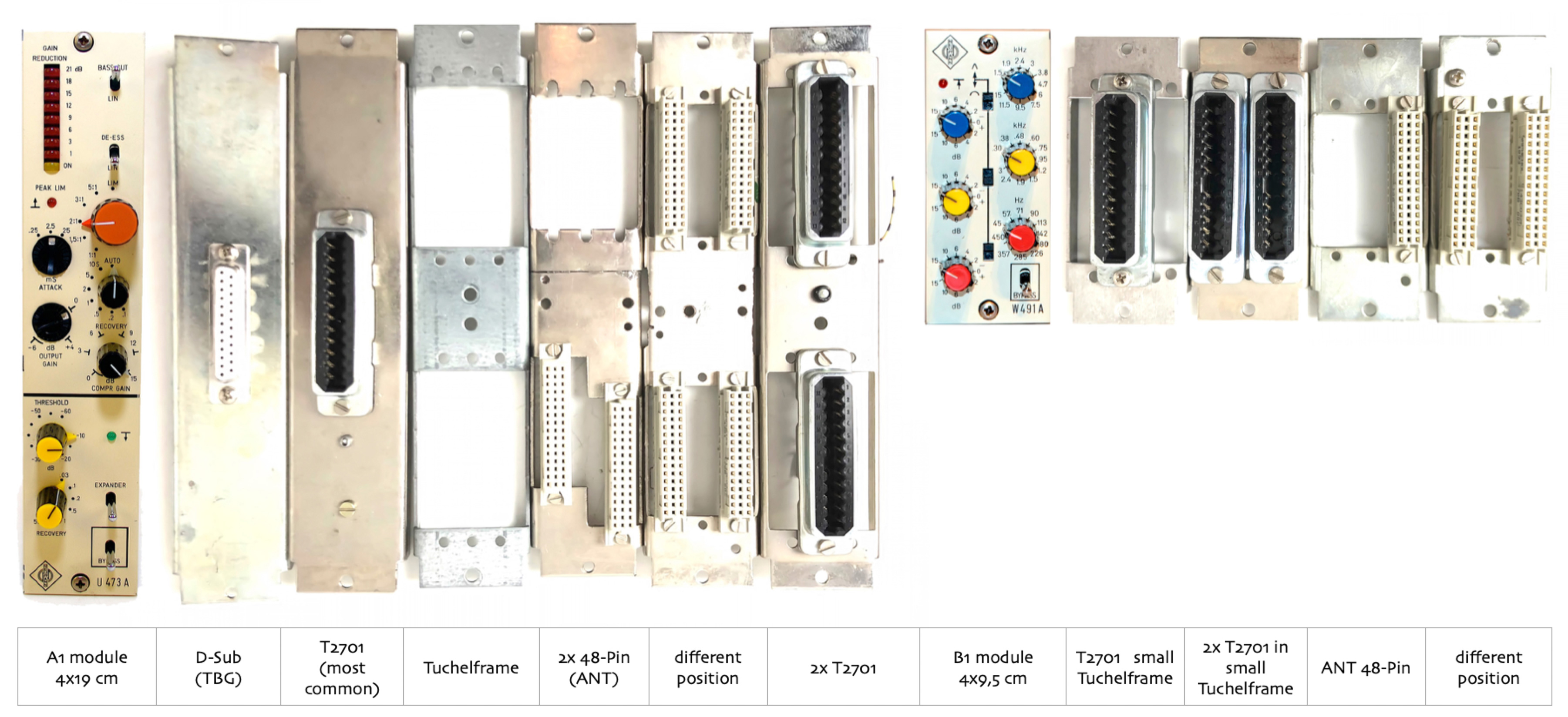the CASSETTE FORMATS of vintage german broadcast equipment
In the vintage german broadcast technology, various formats for mixer cassettes have been introduced over the years and later partially discarded or replaced by newer formats. Instead of relying on a standard from the start, it was a long way to get the A1 and B1 format cassette which ultimately prevailed with all remaining manufacturers from the 1970s until the end of the era of analogue broadcast mixing consoles in cassette technology in the 1990s and thus supplies the largest selection of modules today. It all started promisingly in the 1950s with the V7X series in tube technology, when companies Maihak, TAB, Telefunken and Siemens all manufactured in one casstte standard, but shortly afterwards all manufacturers were cooking their own soup again.In fact, there are certain differences in the design even within these series, which make it significantly more difficult to build a standard 19 inch rack which fits ALL cassttes in one series of modules. The V72a is a bit deeper than the V72, the W295 equalizer of the Siemens Sitral series has a different size than the V276 microphone amplifier of the same series from the same manufacturer and even in the last series of A/B size danner cassettes there are deviations that always require small adjustments when racking them up.
After WW2, it all started with the V7X tube module series. In the course of transistorization, Siemens came onto the market in the 1960s with Sitral technology and TAB and Telefunken with the V300 / V600 format. It was only at the beginning of the 1970s that the A1 and B1 format cassette cassette became a mechanical standard for all manufacturers, which made it possible to mix cassettes from different manufacturers in one console frame with standard slots. The following text is intended to give you a brief overview without going into too much detail.
A CHRONOLOGICAL LIST OF THE CASSETTE FORMATS:
1. TUBE TECHNOLOGY (early 1950s-mid 1960s)

From 1948 onwards, the North-West German Broadcasting Corporation (NWDR) and the IRT (Institute for Broadcasting Technology) developed a new technical standard for German broadcasting together. Between 1949 and 1952 the V72 tube amplifier was developed under the direction of Prof. Nestler (formerly AEG / Telefunken and ELA). It was based on the V40 / V41 amplifier built until the 1940s, but it was improved in terms of circuitry. The V72 had a fixed gain of 34dB and was initially used as a microphone- and later, after the introduction of the V76, as a multi-purpose amplifier. This first post-war series was manufactured very elaborately using tube technology. The modules were manufactured in normal, double and triple widths and were therefore called cassette sizes 1, 2 or 3. Cassette size 1 has the dimensions: 47 x 134 x 265.Modules in cassette size 1 are: V71, V72, V72a, V72b, V74, V74a, V74s, V77, V78. Double width: V76, U73, V530 and V73. The V81 has triple cassette width. Since at that time also smaller companies based abroad, such as SAIT (Belgium) manufactured in this cassette size, the list of manufacturers is not complete. There was no official name for this series of tube modules. It is therefore often called 72 technology today, since the V72 was the first and best-known cassette in this series. On our website we call this series V7X. Suitable racks from vintagetools are called VT7X racks. On the right you can see a restored V72 tube amplifier from the inside.
Below you can see a series of (tube) modules. The W75k filter, which was often used in combination with the Neumann U47 microphone, followed by a V72t. This is the transitorized successor to the V72 tube amplifier. It was still offered in the same module design. The V72t also sounds excellent and is very rare today, since fewer devices were built. The gain on the V72(t) was fixed at 34dB. The V72a offers gain of up to 40dB and can be adjusted with an internal trimmer in the range of 6dB. The V72b also has a max. gain of 40dB while the V74 models are not really suitable as microphone amplifiers due to their low amplification level. The now very sought-after V76, on the other hand, already offers a rotary switch and a potentiometer for gain control and can be comfortably adjusted in the entire range of 0-66dB (V76m) or 0-76dB (V76). The V77 can be bridged on the rear connector or left open, which then enables either 40dB or 60dB amplification. Intermediate stages are also possible by means of (adjustable) resistors. In our VT7x racks we combine a 3-way toggle switch and a 40dB gain PAD for a full range gain controll, when we rack up V77 modules. The V78 has a basic gain of 50dB. With the potentiometer on the front panel, another 0-20dB can be added. Together with our 11-step 40dB PAD the V78 can be adjusted in 1dB steps from 10dB to 70dB. The circuits of the amplifiers V71, V72, V76, V77 and V78 are very similar. They are all equipped with EF804S tubes, but still differ in subtleties. This is also due to the different input transformers, which have different ratios from 1:10 to 1:40. The transformers always contribute a large part to the sound of all vintage modules.

If you want to use one of the old cassettes in the studio today, you need a suitable racking solution and for most modules some adjustments such as switchable and preferably slowly increasing phantom power, a 220V mains supply and a possibility to set the gain. Apart from the V76, the modules all had fixed gain and the levels were controlled with faders. The vintagetools VT7X rack for 1-2 tube modules in cassette size 1 is not only designed to be extremely stable and beautiful, it also has everything you need to use the vintage mixer cassettes in a modern studio. The phantom power rises slowly after switching on to protect the sensitive input transformers with ratios of 1:20 or even 1:40 from the switch-on voltage. The devices were developed in the 1950s and back then 220V came from the power grid. Today the power net often runs between 232V to 238V. Our internal vintagetools power supply has an analog structure and can be fed with 100V / 115V or 230V. The output voltage is always 220V. This allows the tube amplifier to work within specs and protects the tubes. The gain of a V7x module can be reduced by 34dB (40dB) using an 11-position rotary switch. More information about the VT7X rack and the tube cassettes can also be found on our youtube channel
VTLB vintagetools custom lunchbox | TAB V76m
For tube modules with double width (cassette size 2) we have made some very nice and stable solutions for various customers worldwide in the past. Here´s a video showing a nice and stable wooden lunchbox (VTLB) housing a rare TAB V76m mic preamp.
VT7X vintagetools 19" 2U rack for tube modules
The VT7x is the right solution for tube modules of the early post-war period such as the TAB, TELEFUNKEN- Maihak or Siemens V72, the TAB V72a, Siemens V72b, V77, V78 and all other modules in cassette size 1.
2. THE EARLY TRANSISTOR TECHNOLOGY OF THE 1960s
the siemens sitral m444 mixer
With the advent of transistor technology, audio gear could be built much smaller and also all with a lower weight per channel. In this way, more console channels and functions such as aux-sends and subgroups became possible. In the 1960s, Siemens was the first manufacturer to launch Siemens Sitral technology. The M444 mixer with 8 channels and two mono sums was a great success. The V276 and V276a preamplifiers built into it are among the most sought-after modules of this era. The rare Siemens U273 diode bridge compressors, which were available in single and double widths and with different configurations, were unrivaled at the time. It´s often said that even Rupert Neve used this design as a template for his legendary Neve 2254 limiter.
A selection of rare sitral cassettes
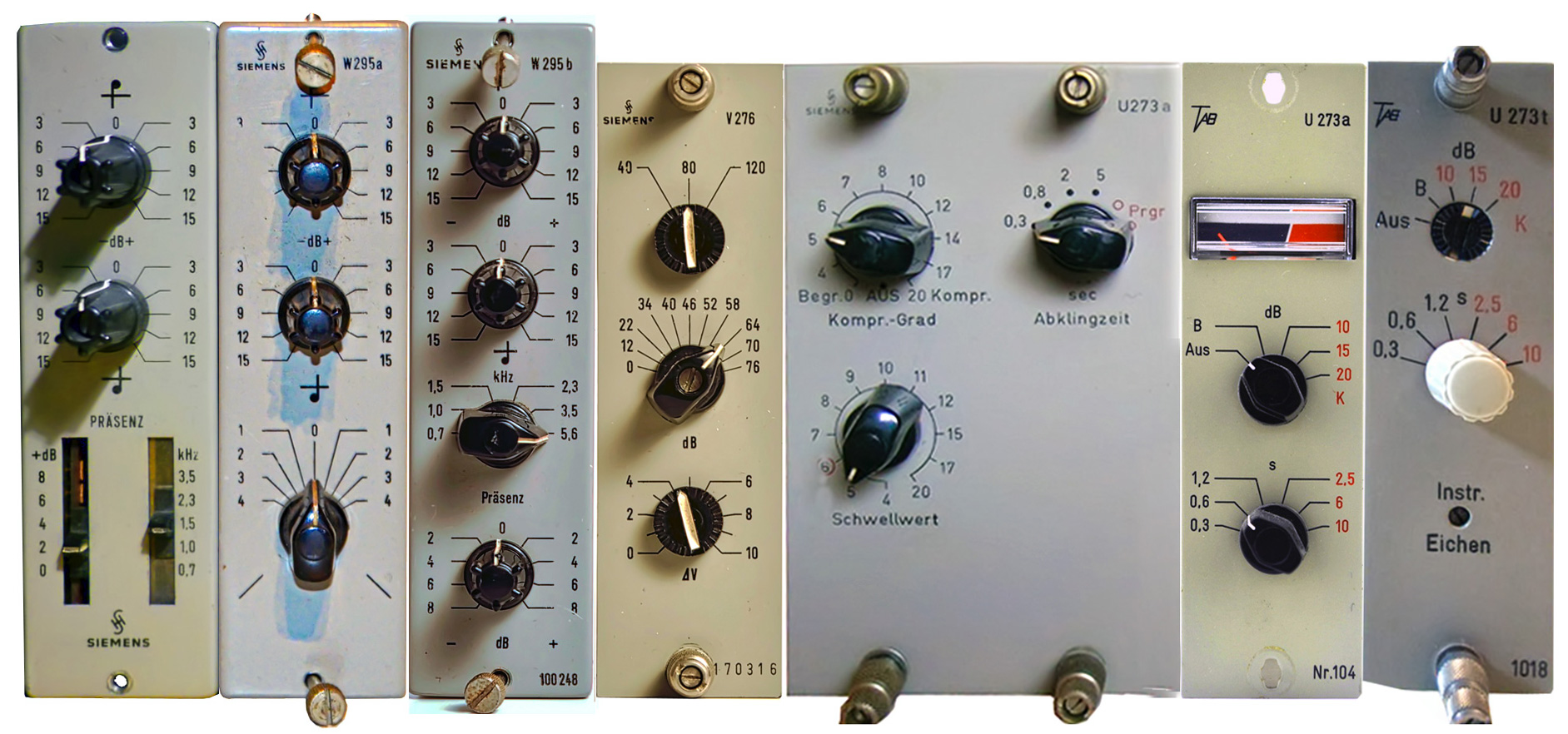
The Siemens Sitral equalizers were available in versions W295, W295a and W295b. They all sound great and it is difficult to recommend a particular one. Unlike most Sitral modules, the equalizers are not connected with the usual 31-pin female connector, but with a 13-pin Tuchel socket. In addition, the equalizers, the H280B generator and some other cassettes, are slightly larger than the other amplifiers in the Sitral series, which are mostly based on euro cards. Just because it is the same series, the same manufacturer and the same decade, the modules of the Siemens Sitral series unfortunately do not fit into the same rack format. In the picture above you can already see the height difference of the modules, but the incompatibility unfortunately continues. The four modules on the right are based on euro cards and fit mechanically in the same rack, but the depth of the modules can vary.
The V276 microphone amplifier is 175mm deep and the limiter has a depth of only 144mm. More confusing: The TAB U273a and the Siemens U273a have similar names, while they are different devices. In fact they TAB U273 versions are closer to the TAB U373. The device identification number of the Braunbuch does not fit here. The first digit "2" actually means SIEMENS and a "3" would be TAB. So the TAB U273a and U273t are really TAB U373 limiters in the Siemens Sitral module size.
Since the cassette sizes of the Sitral series are so different and modules are rare, vintagetools does not (yet) offer a standard rack system. however, we can build wooden boxes or custom racks for our customers on request. Here are some examples:
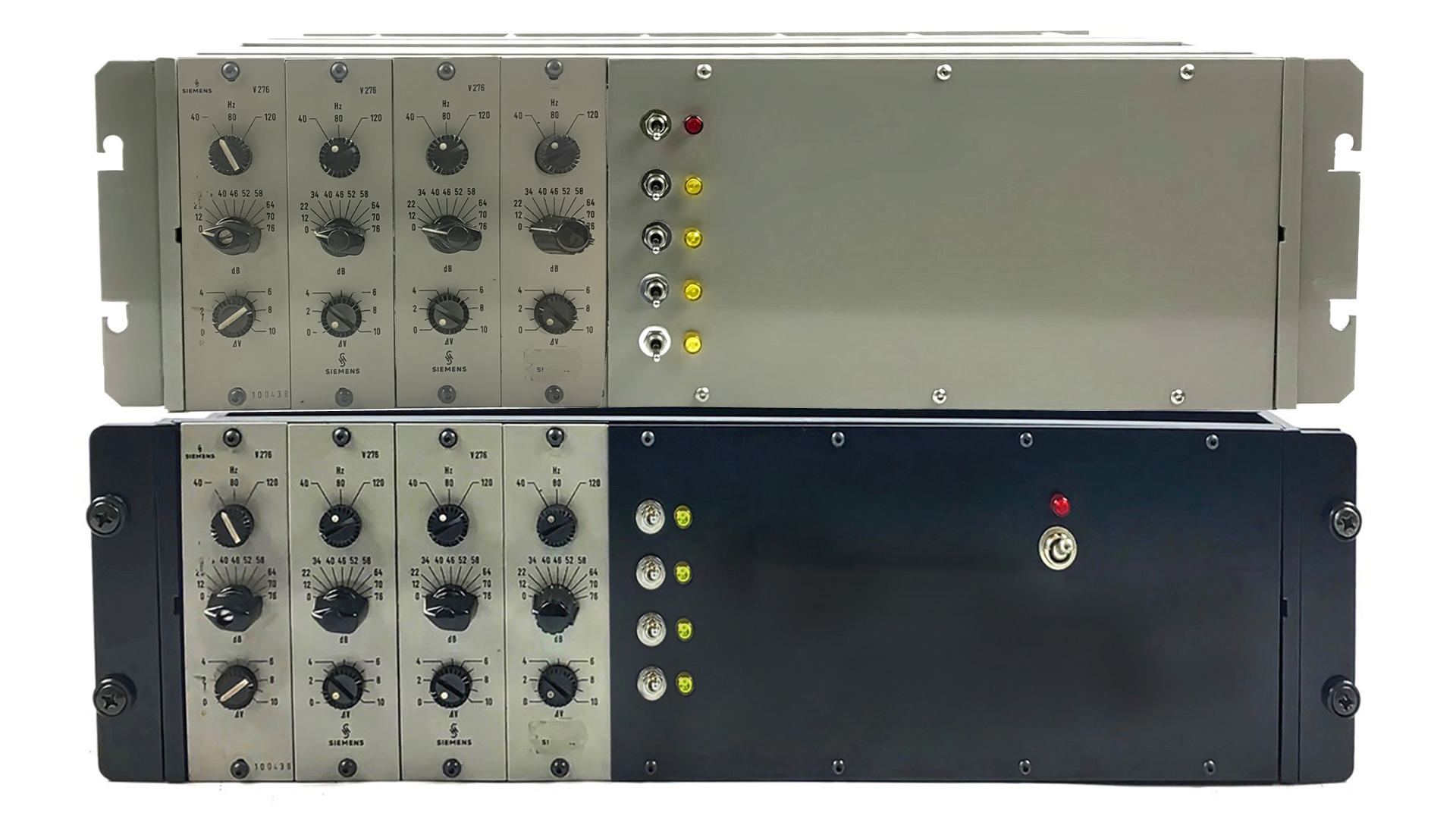
Here you can see a DIN rack (approx. 20.5 ") which was shortened to 19" and loaded with Siemens V276 mic preamps. We added an internal analog power supply (VT2448psu) with individual phantom power per module.
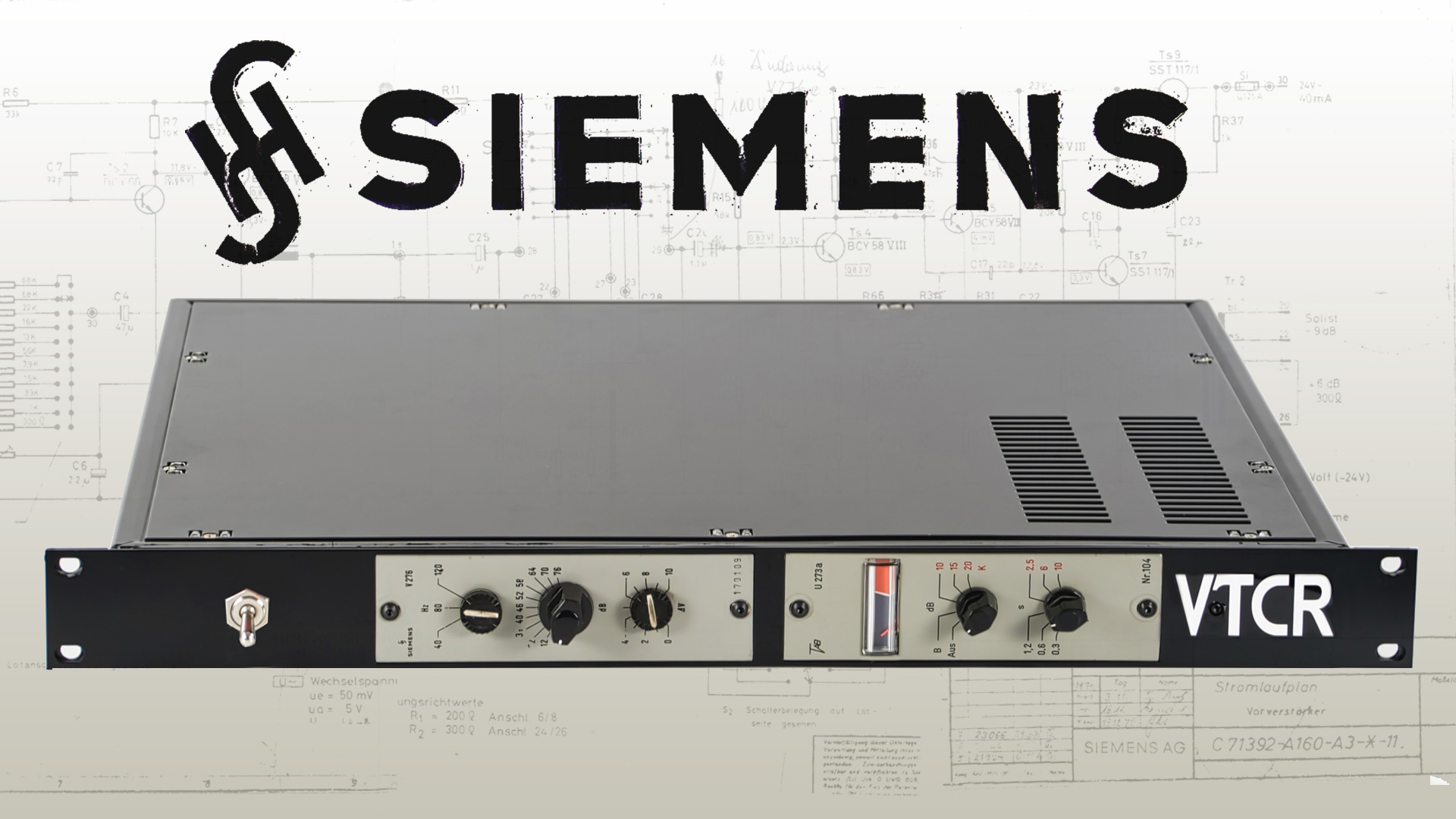
Another custom rack based on a 19 "1U housing. Equipped with a Siemens V276 microphone amplifier and a TAB U273a limiter. It also came with the Internal analog power supply VT2448psu.
3. THE TAB / TELEFUNKEN V300 / V600 SERIES (1960s)
Shortly after the Siemens Sitral series appeared, the manufacturers Telefunken and TAB (Tonographie Apparatebau) came up with their own version of transistorized mixer cassettes. Those were called V300 (TAB) and V600 (Telefunken) technology. The two manufacturers have agreed on a common standard and the cassettes are therefore interchangeable, although not all pinouts are the same. Well-known TAB modules are e.g. the V376 and V376a microphone preamplifier, the U373 and U373b compressor/limiter and the V372 line amplifier. Telefunken did not have its own dynamic limiter like the U373 but an excellent microphone amplifier called V676 and V676a, as well as the line amplifier V672 in it´s program. With the Sitral technology and the V300 / V600 cassettes, also the format of the eurocard was introduced. The eurocard is a pcb board with the dimensions 160 x 100mm and a height of max. 40mm. These cards were used regularly until the end of the analogue era. The Siemens, TAB and Telefunken modules of the 1960s are often nothing more than eurocards with a front plate and sometimes a closed housing around them.
The TELEFUNKEN V672 is the direct successor of the V72 tube amplifier and also offers a fixed gain of 34dB. Like its predecessor, it is versatile and was originally used as a catch-up, distribution or node point amplifier. TELEFUNKEN titeled the V672 as an „universal amplifier“. When modified, the V672 can also be used as an excellent sounding microphone amplifier with higher gain. The original version V672 still had its own TELEFUNKEN made transformer on board. The successor V672/2, which also dates from the 1960s and 1970s, installed the typical round, mu-metal shielded transformers made by Haufe and Pikatron. After TELEFUNKEN stopped building professional broadcast equipment in the mid-1980s, the successor company ANT continued to build the V672a. Under the new brand name ANT the same employees and developers were taken over from TELEFUNKEN. The ANT V672a is based on the same circuit as the original V672 from the 1960s. It is also completely discreet and equipped with Haufe transformers. In other words it is in no way inferior to the quality of the earlier TELEFUNKEN V672/2.
LEFT to RIGHT: TELEFUNKEN V672 | successor TELEFUNKEN V672/2 | ANT TELEFUNKEN V672a/2
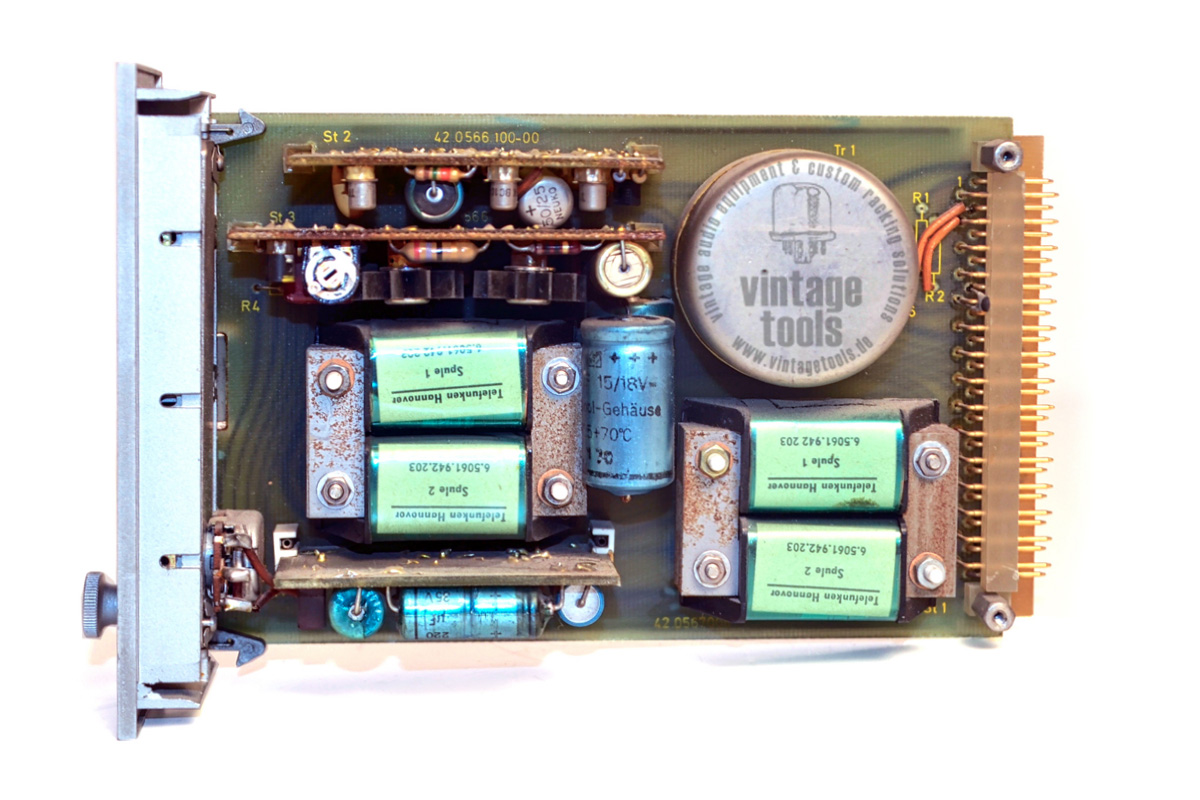
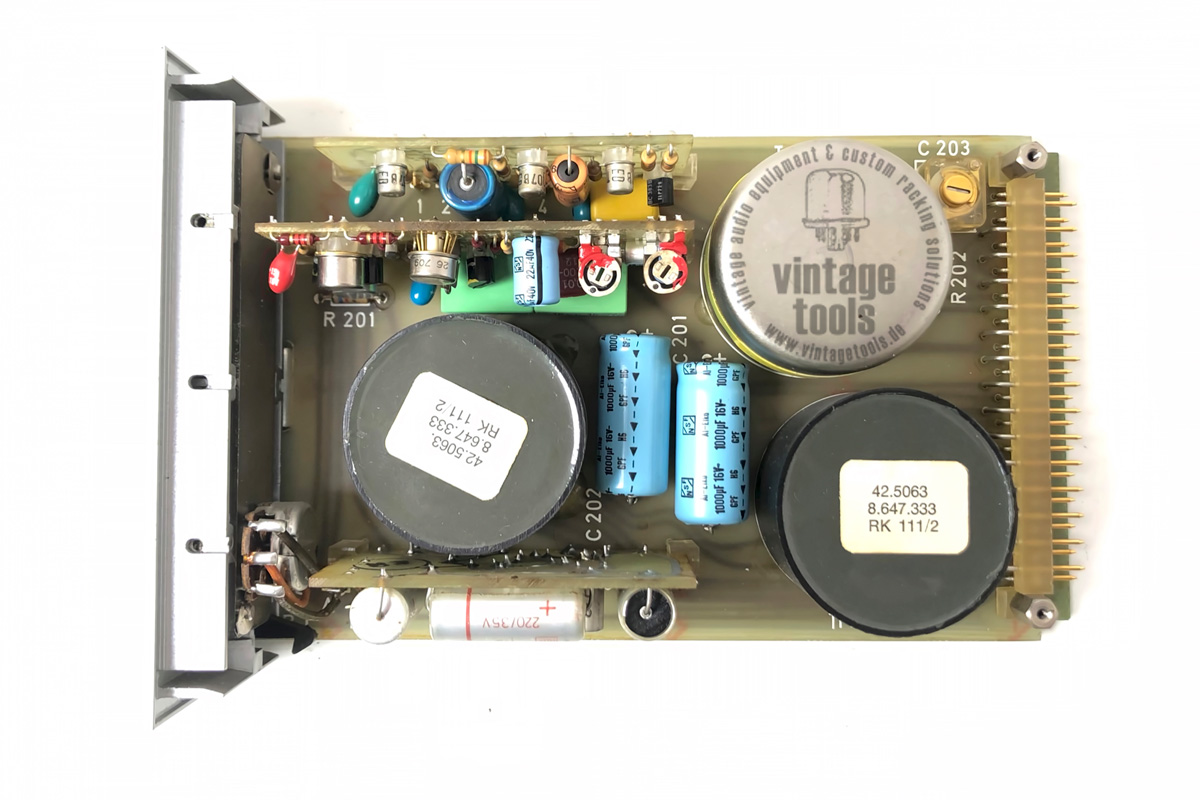
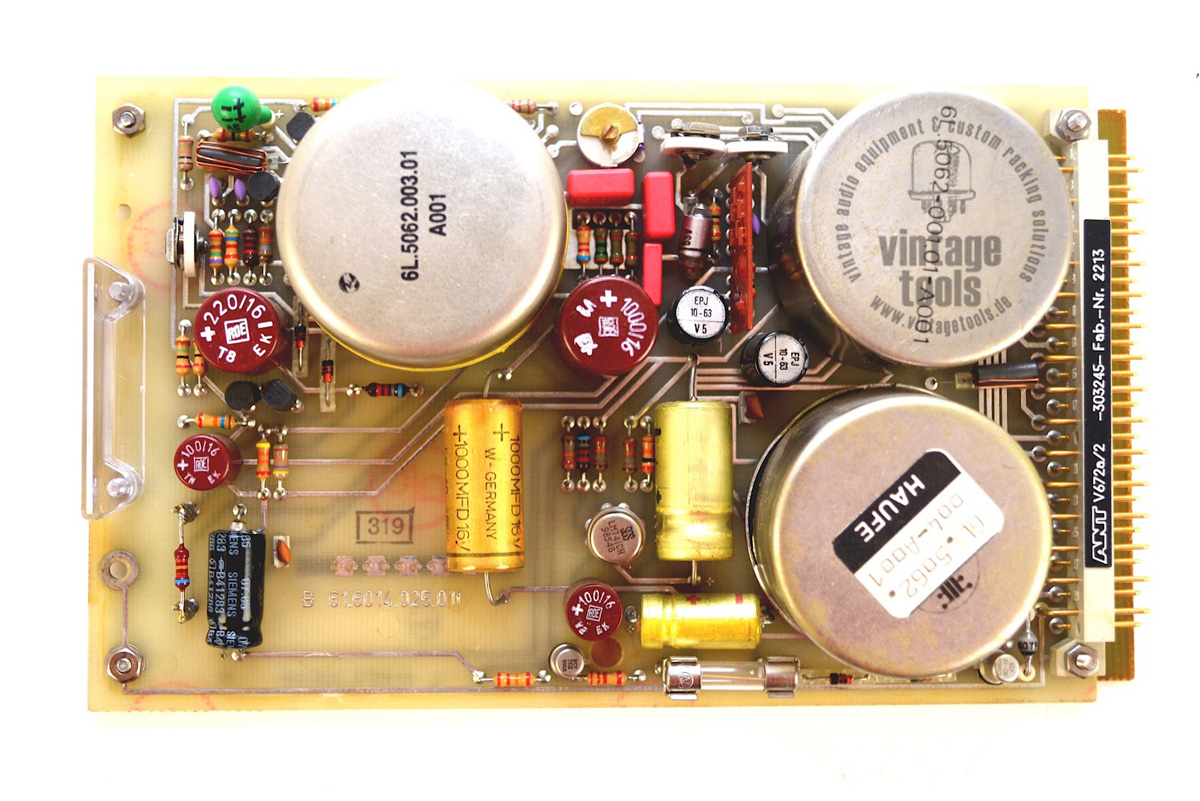
the VINTAGETOOLS VT672 mic preamp
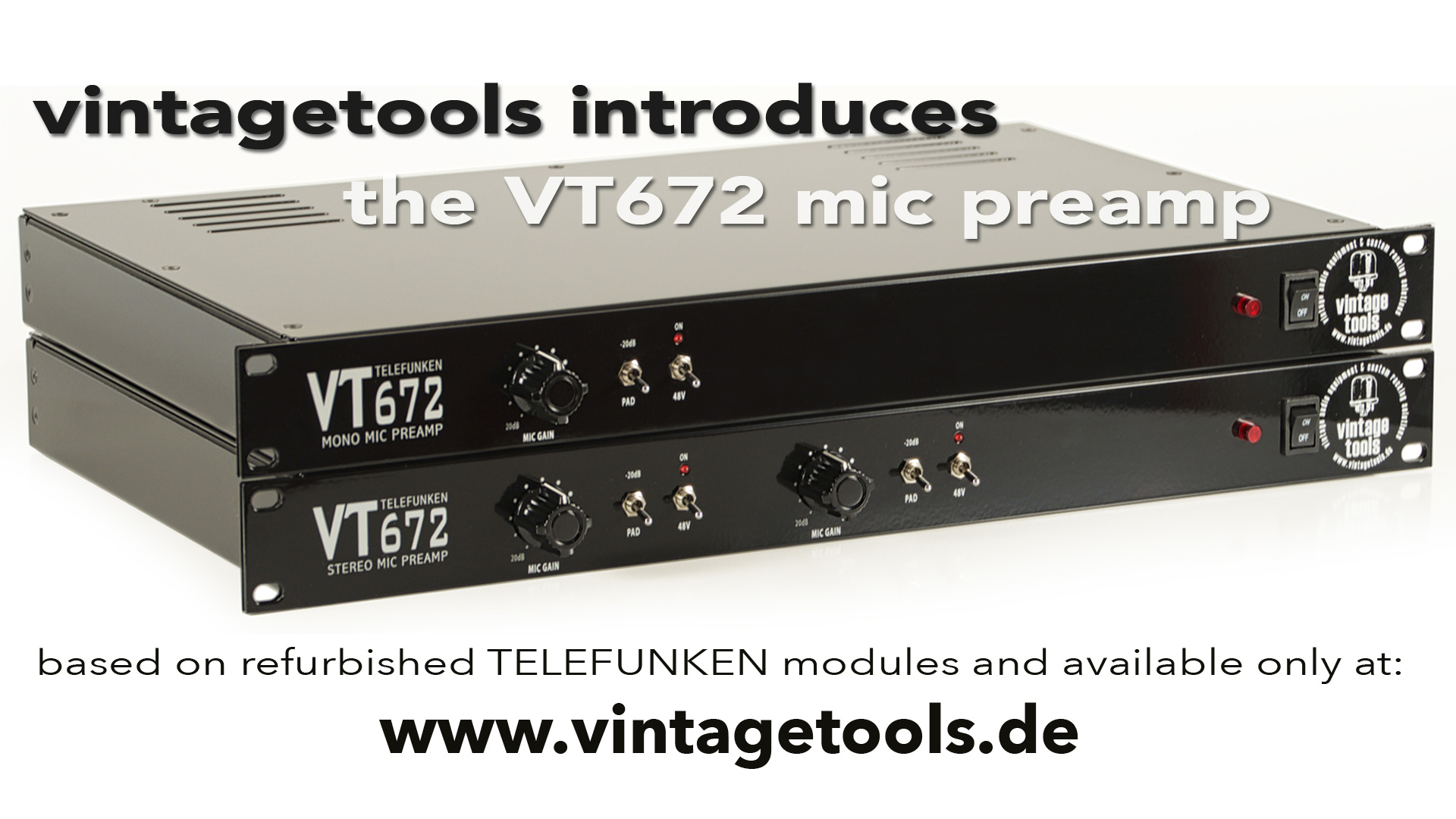
The vintagetools VT672 microphone preamplifier is based on a revised Telefunken (ANT) V672a / 2 amplifier card from the 1970s. With the typical, fat sound of analog broadcasting technology, the VT672 microphone preamplifier is suitable for almost all areas of application. It is very popular for voice and vocal recordings, where its pleasant mid-boost stands out positively. But also for electric guitars. It is ideal for drum overheads and many other applications. Thanks to a modification, the vintagetools VT672, in contrast to the original V672 euro card, provides up to 60dB gain with a linear frequency response. The VT672 is available as a mono or stereo device and exclusively available from Vintagetools. If you are interested, please also watch our product video for the VT672 on Youtube!
4. THE LATEST form of mixer cassettes | danner A/ B format | 1970s to mid-1990s:
The A (19x4cm) and B (9.5x4cm) format cassette has actually been around since the 1950s, but it was only in the 1970s that it finally became the standard format cassette in vintage german broadcast mixers. Previously, this cassette size was mostly used by the companys "K. Danner Berlin", "Maihak" or "Eckmiller", which supplied the faders for various analog mixing consoles. Eckmiller also offered filters and equalizers in this cassette size. Therefore, in the early tube mixer amplifiers (V72 / V7X) and in the early transistor consoles amplifiers, equalizers and other modules in the Siemens Sitral or TAB V300 or TELEFUNKEN V600 format were always paired with faders in the Danner format A1.
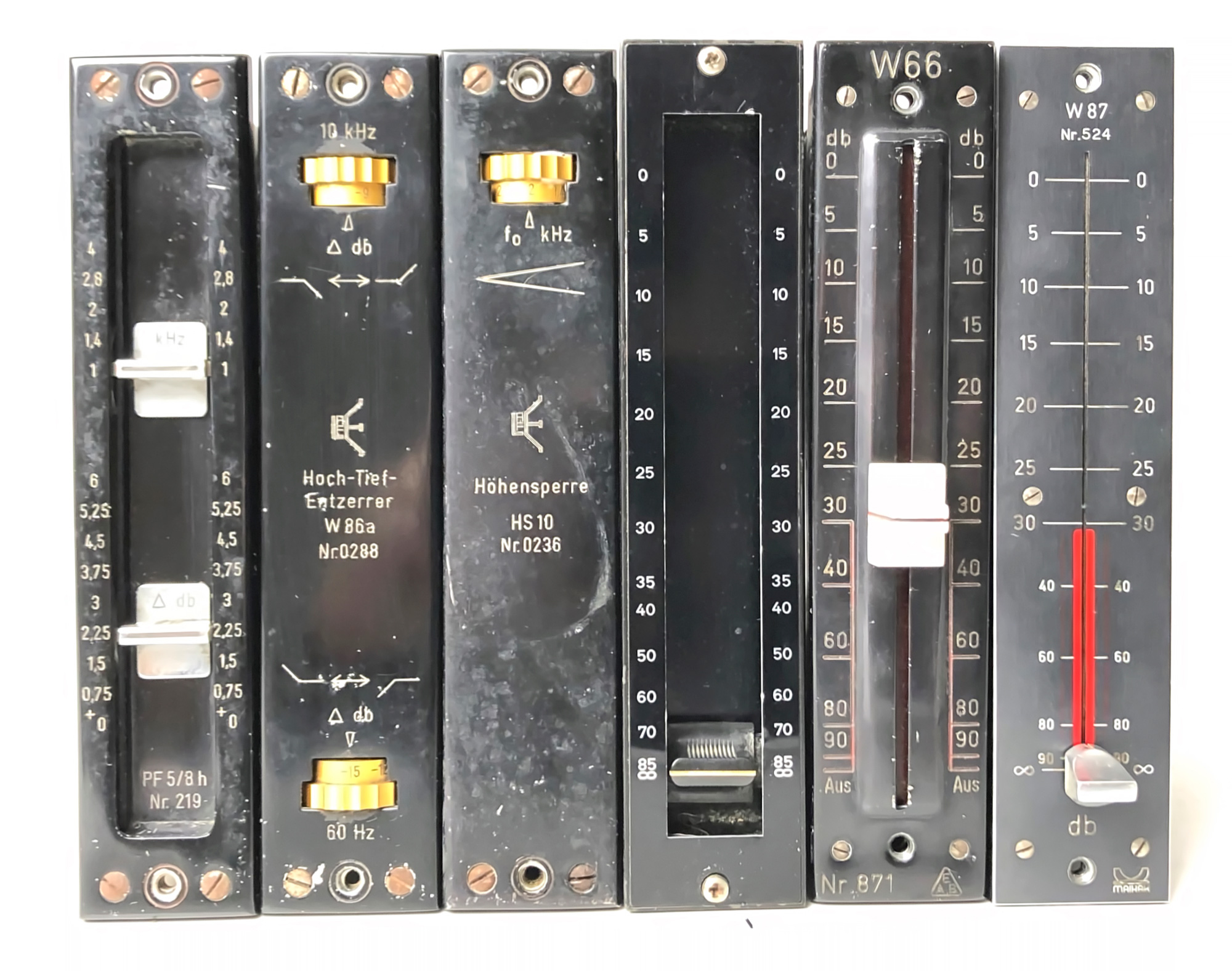
Above you can see some of the early cassettes in the A1 format. They were manufactured by Maihak, EAB, K. Danner and Eckmiller. The faders, as well as the filters and equalizers shown, were passive and the attenuation of mostly -34dB had to be made up with amplifiers like the V72, V72a, V72b or the later solid state versions V272, V67,2 etc. to compensate the gain loss. The quality of these early passive modules was exorbitant. The Eckmiller modules in particular were mechanically extremely complex, as you can see from the example of this open high-pass filter. The W88 fader was also built with hand-wired resistance decades instead of the later "carbon layer potentiometers".
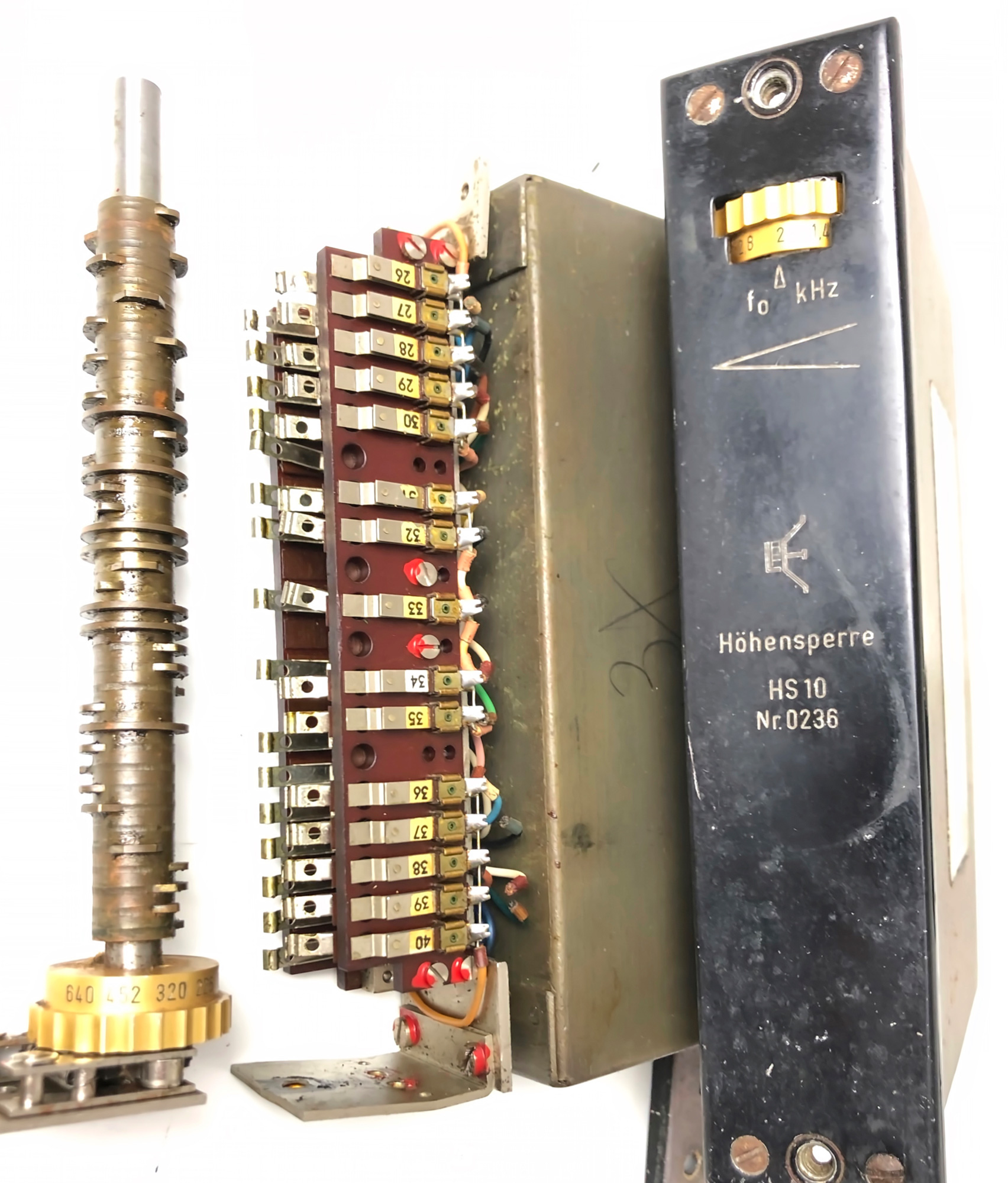

From the 1970s to 1990s, more companies entered the pro audio and broadcast market to build mixers, cassettes and euro cards for radio and television stations. After Telefunken withdrew from the broadcasting technology division, the established manufacturers TAB, Telefunken, Siemens and Neumann were joined by the TELEFUNKEN successor ANT, EMT and the companies Lawo, Monitora, NTP, RTW, BFE, Filtek, Arnold, Hensman, Delta , Adis, Barth, TBG. Since in addition to the well-known classics, many special cassettes were built, it is not possible to create a complete database. Although we at vintagetools have been dealing with analogue German radio technology for 20 years, we still find cassettes that we have never seen before.
Thanks to the variety of modules built, this cassette form is ideal for a custom mixer project. For a mixer you will need as many of the same special cassettes as possible. Aux-sends, panorama, routing functions etc. are required for each channel for such an undertaking and it is not easy to find them. When broadcasters began to separate from their mixing consoles, preamplifiers, equalizers, compressors, faders and metering were sometimes "saved", but frames, mechanics, connectors and special cassettes were often thrown away. When planning and building our own vintagetools custom console, it was difficult to find many of the same pan, aux send and routing modules. Preamplifiers, equalizers, compressors are more expensive, but you can gradually buy them one after the other, as they show up on ebay or Reverb frequently. However, getting the same special cassettes from different sources turned out to be extremely difficult.
types of connectors and frames for the danner A/B Format
After the manufacturers had finally more or less agreed on the same cassette format in the early 1980s, the cassettes and cards were at least mechanically compatible. This greatly facilitated the planning and implementation of projects in radio and television stations, as well as in their OB vans. However, the standardization of the cassette formats never went so far as to agree on a standard pinout. Unlike the API-500 format, it is therefore not possible to swap the cassettes in a rack or desk. In the very early danner cassettes, 8-pin or 12-pin connectors were often used. The 13-pin Tuchel (T2706) socket was introduced with the Sitral technology. It was later also used in the A / B format cassette tapes until the 23-pin Tuchel (T2701) socket later was established. When these connectors became rare and expensive towards the end of the era of analog radio technology, some manufacturers such as the Telefunken successor ANT switched to other formats. In addition, there are not only different connector formats, but they can also be mounted in different positions for both the small and the large cassettes. In short: All racks and mixing consoles have to be planned precisely and built individually according to customer requirements.
Below you can see an overview of the different connectors and sockets for danner cassettes. The plugs are fixed in a floating manner in the so-called "Tuchel bridges". That way modules can be easily removed and re-inserted during operation. These Tuchel bridges are also installed in the vintagetools racks VT19-1U and VT19-5U. After receiving the rack, you can simply slide your modules in from the front and secure them with the two fastening screws. The picture below shows how difficult it is for us as a supplier of small series to plan a rack housing that fits all or at least as many different modules as possible. without looking bad.
The D-Sub connector was rarely used. The Munich company TBG used it in their desks. The 23-pin Tuchel T2701 connector was mostly used from the 1970s on, while ANT opted for the cheaper three-row 48-pin connector. The double-sized socket strip with 96 (64) pins was often used for euro cards. Alternatively, there was a 31-pin socket connector for euro cards. Not shown is the 13-pin Tuchel socket T2706, which is visually similar to the T2701, but only has 13 pins and is therefore smaller. The very early connectors, e.g. 8- or 12-pin Tuchels, as well as the 36-pin Amphenol used towards the end of Neumann are also missing in the picture.
mixers and racks for danner cassettes in the A/B Format
Thanks to many manufacturers and a large selection of modules, at least mechanically compatible, broadcasters could now have mixing consoles tailored to their individual needs. You could find mixing consoles from the manufacturer Lawo, which were equipped with Neumann U473A or NTP 179-120 compressors, NTP or RTW bar graphs and special cassettes from other manufacturers such as Monitora.
Plasma-, LED- or VU-meters were mostly manufactured by NTP in Denmark or RTW in Germany and then used by mixer manufacturers such as Neumann, Telefunken, Siemens, Lawo or Monitora. Lawo and Monitora did not have an own limiter module and used the Neumann U473, NTP 179/120 or 179/160 or the BFE-Filtek BKE 1-4 series for their mixing consoles. Thanks to the strict standards of the ARD and IRT, there are hardly any quality differences between the manufacturers. All German manufacturers only used transformers from the companies Haufe and Pikatron, both of which are interestingly located in the same small town (Usingen). The Danish company NTP installed equally good Lundahl transformers and we have seen some modules and euro cards with Beyer transformers too. The rotary switches often came from the Swiss company ELMA or ebe. Akll that gear was build after the highest possible standard and prices hardly played a role . Maximum quality was the measure of all things.
vintagetools VT19 Racks for A/B danner cassettes
Vintagetools offers several racking solutions for the A1 and B1 format. Our VT19-1U rack offers space for two large A1 or, alternatively, up to four B1 modules, which are installed horizontally. The housing can be delivered empty or equipped with cassettes. It contains the analogue VT2448 power supply, which in addition to the 24V for the supply of the cassettes also provides 48V for the phantom power. The VT19-5U rack can hold up to ten A1 or 20 B1 cassettes and requires a stronger, external power supply. The cassettes are installed upright here. In the past, we also built some custom racks and lunchboxes for this type of cassette. Below are a few examples:
We are happy to advise our customers on the various rack series and all imaginable custom solutions such as a mastering setup, a Trakker for recording or a summer with a mix matrix expanded by faders, groups, aux-sends. We have even planned and built a complete 32/8/4 channel mixer consisting of Telefunken and Neumann cassettes in the past. More about this mixer project can be found here soon.

 English
English
 Deutsch
Deutsch
